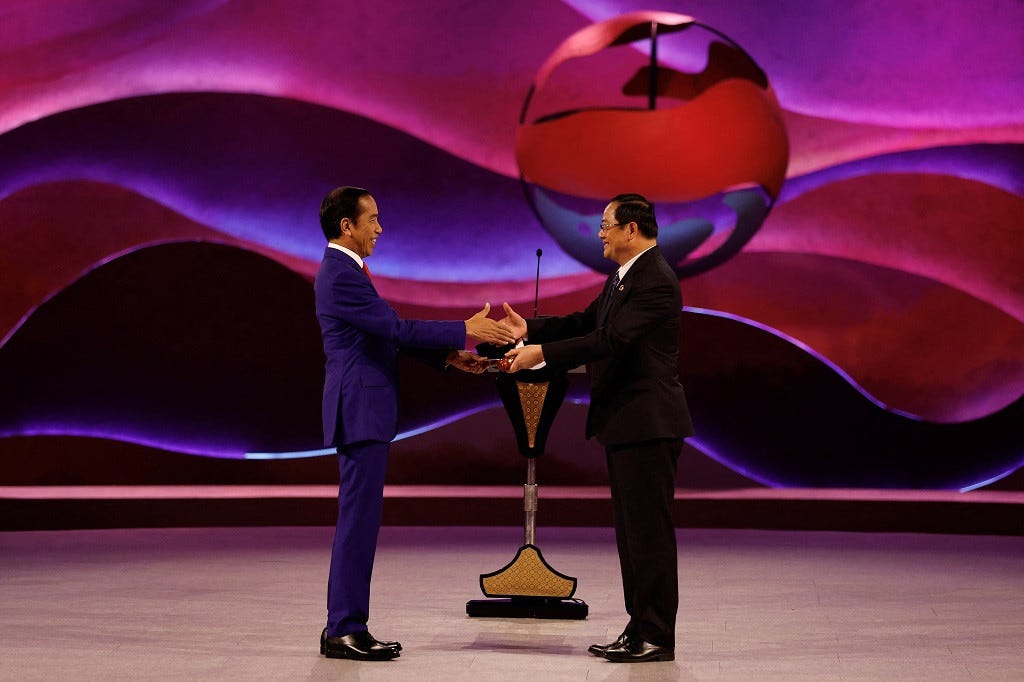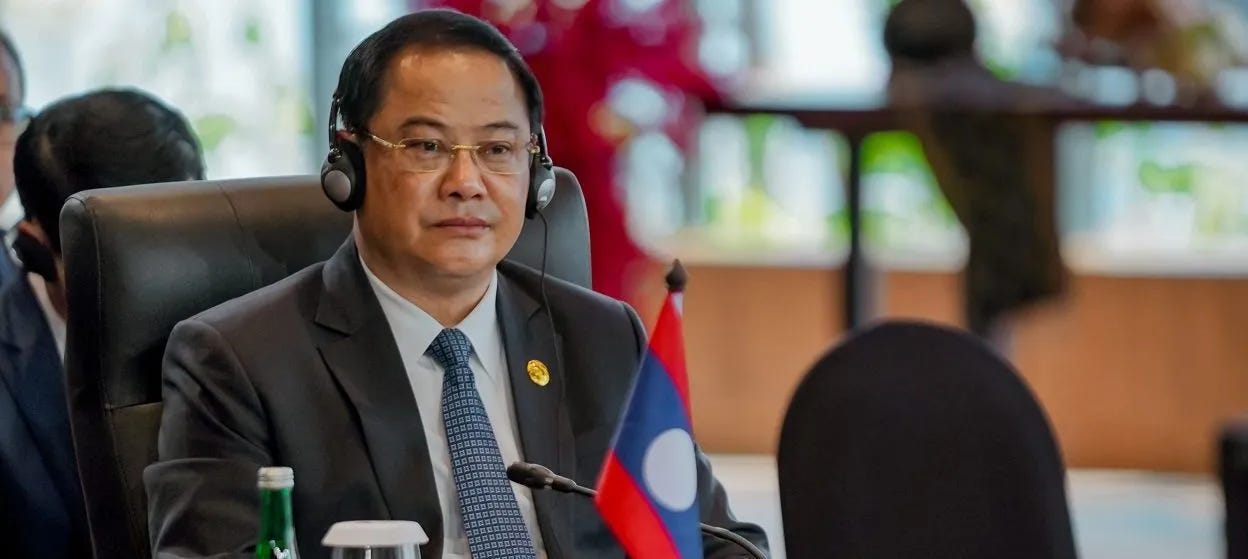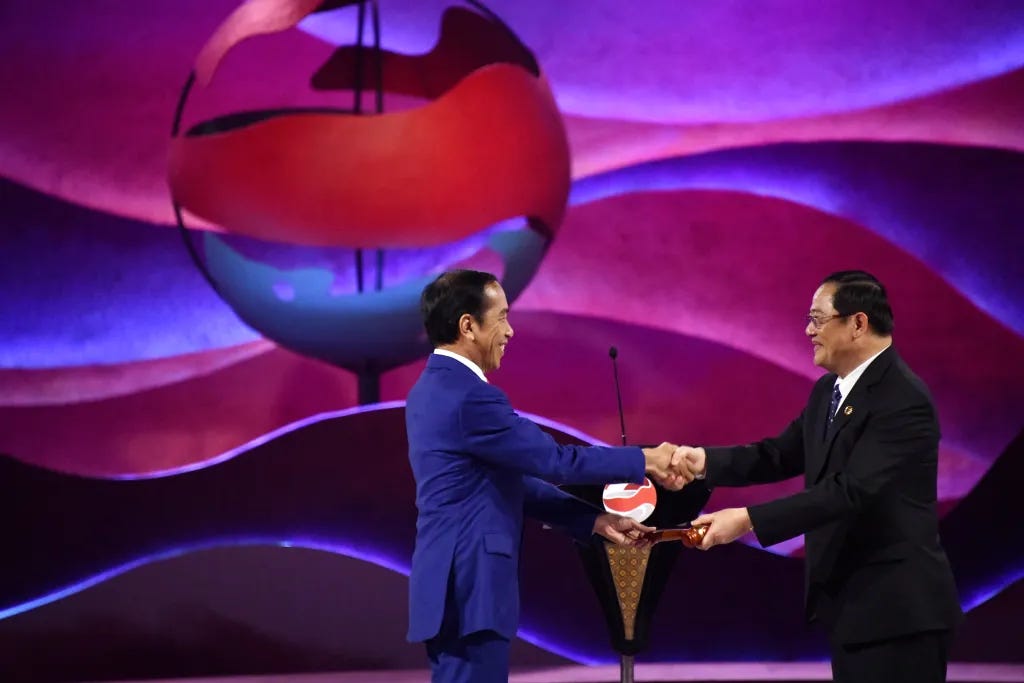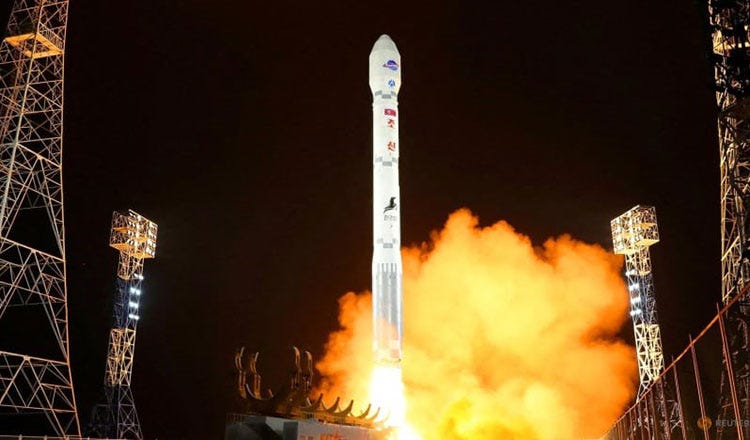ASEAN Aspect
UPDATE: In welcoming Laos as the 2024 ASEAN chair, fellow member states should take real measures to not only help Vientiane realize its agenda, but also support its bid to boost the country’s tourism through its Visit Laos Year 2024 program.
Laos is preparing to take up the Chairmanship of ASEAN for the third time in 2024. Unlike its previous experiences as chair in 2004 and 2016, 2024 may prove to be even more demanding as Laos is expected to lead ASEAN through another tumultuous year of challenges.
North Korea has long been a source of fascination for people throughout the world because of its secretive government and contentious policies. Among its many projects, the nation’s creation of a spy satellite program has drawn criticism and caused anxiety among ASEAN neighbors.
Laos’ ASEAN chairmanship
By Editorial board (The Jakarta Post)
In welcoming Laos as the 2024 ASEAN chair, fellow member states should take real measures to not only help Vientiane realize its agenda, but also support its bid to boost the country’s tourism through its Visit Laos Year 2024 program.
This is the third time Laos is helming the 10-member trade bloc, after its previous turns in 2004 and 2016.
Despite its smaller population and economic size compared with ASEAN’s founding nations, the region’s only landlocked country proved its mettle when it assumed the chairmanship in the past. However, it would be unfair to expect Laos to offer major breakthroughs that help the group solve its perennial problems, when big neighbors like Indonesia could not.
We are confident that Laos will address at least three major issues.
First, ASEAN leaders decided at last year’s summit that they would not allow Myanmar’s military regime to host any summits and meetings for an indefinite time, including in 2026, when the Philippines will chair the bloc instead of Myanmar as in the original rotation.
Until now, junta leader Gen. Aung Min Hlaing has been demonstrably unable to respect the Five-Point Consensus as the basis of the solution to the Myanmar crisis, which includes bringing an immediate end to violence in the country and hold a dialogue among all parties.
At the most recent summit in Jakarta, the region’s leaders set up a troika on Myanmar with Laos as the current chair, along with Indonesia as the previous chair and Malaysia as the 2025 chair. Its purpose is very clear: to prevent the current chair from violating ASEAN’s decision on Myanmar.
Second, Laos will stick to the bloc’s position on the South China Sea dispute. Laos is not a claimant, while Brunei, Malaysia, the Philippines and Vietnam claim parts of the resource-rich sea. China will naturally seek every path to try and make ASEAN soften its stance on the long-standing issue.
One of the worst ASEAN summits took place in 2012, when then-Cambodian prime minister Hun Sen blocked the inclusion of the South China Sea issue in the leaders’ joint statement. Let that be the first and last scandal for ASEAN, and we are confident that Laos will not commit such a blunder, as it proved in 2016.
This year, ASEAN faces much more complicated challenges not just in the region, such as the conflict in Myanmar and the rising tension between the Philippines and China over the South China Sea, but also the growing great power rivalry in its backyard, the Taiwan issue and the arms race in the Asia-Pacific. North Korea’s nuclear threat also poses a danger to peace in Southeast Asia.
As the 2024 ASEAN chair, Laos has decided on the theme "Enhancing Connectivity and Resilience", reflecting its ambition to create a more connected and resilient bloc through the united effort of other member states.
The first pillar involves enhancing regional cooperation, expanding ASEAN’s external relations and strengthening ASEAN unity and centrality in the evolving regional architecture for regional peace, stability and development.
The second is to enhance connectivity, narrow the development gap, promote carbon neutrality and advance digital transformation and economic integration, while the third is to promote people-to-people exchanges and cooperation for climate resilience and health development.
Last but not least, Laos has the mandate to accelerate the admission of Timor-Leste as ASEAN member. In 1996, then-president Soeharto succeeded in convincing his regional counterparts to welcome Laos, Myanmar and Cambodia to the group, with the first two joining in 1997 and the latter in 1999.
Soeharto thought then that this bring the whole region into the ASEAN fold. But history proved him wrong in 1999, when East Timor decided to separate from Indonesia and eventually became the sovereign nation of Timor-Leste on May 20, 2002.
Congratulations to Laos on this year’s ASEAN chairmanship, under which the governments and peoples of Southeast Asia hope that the bloc can play a more pivotal role in both regional and global affairs.
Laos as ASEAN Chair: Flying into Headwinds
By Joanne Lin
Laos is preparing to take up the Chairmanship of ASEAN for the third time in 2024. Unlike its previous experiences as chair in 2004 and 2016, 2024 may prove to be even more demanding as Laos is expected to lead ASEAN through another tumultuous year of challenges.
At the 24th ASEAN Lecture, organised by the ISEAS-Yusof Ishak Institute on 7 December, Deputy Prime Minister and Foreign Minister of Laos, Saleumxay Kommasith was forthright in putting across a long list of multi-dimensional challenges facing ASEAN. This includes strategic competition between the major powers, the situation in Myanmar, the South China Sea, Korean Peninsula, Middle East, and Ukraine, the fragile global economic recovery, climate change and natural disasters. Laos has framed the 2024 theme as “ASEAN: Enhancing Connectivity and Resilience”.
Not unlike previous chairs, Laos has promised to keep ASEAN relevant by enhancing its resilience and promoting its centrality to overcome these challenges. At the handover ceremony of the ASEAN Chairmanship in September 2023, Laos’ Prime Minister Sonexay Siphandone highlighted that Vientiane would focus on further consolidating the ASEAN Community including enhancing connectivity and economic integration, narrowing the development gap, advancing digital transformation, promoting people-to-people-exchanges, climate resilience and health development. These areas are now translated into Laos’ designated priority areas of cooperation as unveiled by Mr Kommasith at the ASEAN Lecture.
In a media interview last month, the Foreign Minister expressed Laos’ determination to turn challenges into opportunities. It is looking forward to hosting close to 400 meetings and bringing a record number of people and tourists into Laos under its “Visit Laos Year 2024”.
More importantly, Laos wants to boost its standing and influence among major powers as it hosts and chairs meetings in all ASEAN-led mechanisms, including the East Asia Summit where the leaders of major powers including the U.S., China, Japan, India, Australia, South Korea, Russia, and New Zealand will be gathered in Vientiane.
As a small and landlocked country in ASEAN, Laos is vested to amplify its interest and broaden its economic options. As such, it has pulled out all the stops to succeed in its Chairmanship — at the least, in the procedural and logistical aspects. It was reported that the Laos National Steering Committee on the Chairmanship has started work on the improvement of roads and airports, budget, meeting venues, communication and internet facilities, tourism destinations, accommodation and other logistics associated with government delegations and foreign journalists. Most ASEAN dialogue partners are also quick to offer their support, such as the provision of logistical equipment such as vehicles and IT systems, capacity building and English language training.
To its credit, Laos has had a fairly decent track record as ASEAN Chair in 2016. The country has demonstrated that it was able to strike a compromise between opposing voices (the U.S., China, Vietnam and the Philippines) on the South China Sea. That was the lesson learned from the failure to issue a joint communique in 2012 during Cambodia’s Chairmanship due to disputes over language to frame the South China Sea disputes. While it is unlikely that the Code of Conduct in the South China Sea (COC) will be adopted during Laos’ Chairmanship, Vientiane would be expected to adopt a neutral position. However, such an overly cautious position may not revive the languished negotiations.
Despite its earlier success, Laos should not rest on its laurels. Although it has put forth a list of priority deliverables, they reflect the country’s risk-averse disposition and preference to focus on the safer aspects of ASEAN Community-building. As there are no specific details on what Laos plans to deliver, it remains to be seen if there will be new concrete initiatives for ASEAN apart from a long list of statements and declarations.
Laos’ inward focus stands in contrast with Indonesia’s outward and bold approaches as evidenced in its push for greater cooperation in the Indo-Pacific. As the Chairmanship is being passed from the biggest and boldest country in Southeast Asia to one of the smallest developing countries in ASEAN, observers are concerned about Laos’ ability to lead ASEAN in navigating through new geopolitical and economic developments. These concerns are valid: if Indonesiadid not secure much success, Laos, with a significantly smaller weight, has its work cut out for it. Furthermore, there are doubts as to whether Laos would be a neutral Chair of ASEAN, considering its close ties with China. Some observers noted that debt pressure may result in Laos acting at the behest of its bigger northern neighbour. This might affect Laos’ chairing of key negotiations such as the COC.
To compound matters, the challenges today are unlike 2016. The region will be watching to see how Laos handles regional flashpoints and issues, particularly the Myanmar crisis and the South China Sea. Following Operation 1027, Myanmar is witnessing unprecedented resistance attacks by anti-junta forces which could potentially see the weakening or even collapse of the Myanmar military government. As much as Laos has affirmed that it will continue with a “full and effective implementation of ASEAN’s Five-Point Consensus (5PC)”, the situation in Myanmar may change dramatically to render the 5PC inadequate to address the new situation, especially if the country were to break up. As conservative as Laos is, it will certainly need greater flexibility, adaptability, and creativity to find new solutions to assist Myanmar and its people. Laos will need to lead ASEAN in stepping up humanitarian efforts in affected states and address off-limits issues such as refugees given the widespread displacement of the Myanmar people.
Similarly, as tensions between China and the Philippines worsen in the South China Sea, ASEAN cannot continue to be a bystander. As a land-locked country, it is questionable whether Laos would have the gumption to make a difference on the South China Sea issue and make ASEAN’s relevance count. At least, Laos will be pressured to make progress in the negotiations of the COC regardless of whether such a document may be effective in situations of conflict.
Apart from rising tensions in Myanmar and the South China Sea, North Korea is expected to raise tensions in the region with more intercontinental ballistic missile tests. Middle powers including South Korea and Japan are expected to respond more strongly with greater military actions. The upcoming high-stakes election in Taiwan next month, depending on the outcomes, could further deteriorate the situation in the Taiwan Strait.
Even in the realm of easy wins — the attendance of the United States president at the ASEAN summits in 2024 — Laos looks likely to get the short end of the stick. In 2016, Laos saw the participation of U.S. President Barack Obama — the first American president to visit Laos. It is unlikely that President Joe Biden will attend the summits in October next year given that the presidential elections will be around the corner. Biden skipped the ASEAN summits in Jakarta in September.
Despite all of Laos’ good intentions and desire to be a competent chair, current realities and facts on the ground mean that it would be quite a hill to climb for Vientiane in 2024. The country will have to dig deep.
North Korea’s Spy Satellite’s Impact on ASEAN Countries
By Dr. Seun Sam
North Korea has long been a source of fascination for people throughout the world because of its secretive government and contentious policies. Among its many projects, the nation’s creation of a spy satellite program has drawn criticism and caused anxiety among ASEAN neighbors.
The development of space technology by North Korea is not a recent development. The nation started launching satellites into orbit in the 1970s, which is when the space program got its start.
There is increasing suspicion that North Korea’s space program serves as a front for the development of military surveillance capabilities, even though the stated goals of these satellite launches have been to promote scientific research and telecommunications capabilities.
It is important to recognize the potential effects of North Korea’s spy satellite program on the ASEAN nations. North Korea obtains a strategic edge that could endanger the security and stability of the region: the capacity to observe operations and acquire intelligence from space. Because of their proximity to North Korea, the ASEAN countries are especially open to potential military or surveillance operations made possible by these satellites.
Spy satellites can take detailed pictures of the Earth’s surface even from hundreds of kilometers above thanks to their advanced imaging sensors and communication systems. These satellites are capable of keeping an eye on a wide range of activities, including infrastructure development, natural resource exploitation, and military deployments. These satellites’ data can be utilized for military planning, information gathering, and threat monitoring.
Concerns are raised among ASEAN nations regarding North Korea’s spy satellite after its capabilities were made public. Considering the nation’s past of conflict and instability, the placement of a spy satellite may have an effect on regional security dynamics. It might provide North Korea better surveillance powers, allowing them to keep a close eye on military maneuvers, other countries, and possibly even critical intelligence.
North Korea might be able to obtain sensitive information about military movements, economic activity, and perhaps political events in the ASEAN nations with these new capabilities. Concerns of regional destabilization and national security are brought up by the recent spy satellite of the North Korea.
In addition, North Korea’s revelation of this surveillance satellite conveys a strong statement about its might and scientific prowess. It acts as a reminder that the nation is still developing its capabilities and making an impression on the world arena in spite of diplomatic efforts and international sanctions.
The ASEAN nations must now carefully assess how North Korea’s spy satellite might affect their own national security and take the appropriate precautions against any dangers. This might entail bolstering regional cooperation, improving their own monitoring and intelligence capacities, and holding diplomatic talks to address this recent development.
The geopolitics of the area may be significantly impacted if North Korea is found to possess a spy satellite. It might tip the scales of influence and power in the area, escalating tensions and possibly sparking conflict. The nations that make up ASEAN would have to reevaluate their alliances and diplomatic ties to make sure that their interests are safeguarded in this changing environment.
The possibility of espionage is one of the main worries for ASEAN nations. Sensitive information regarding military installations, key locations, and defense capabilities of ASEAN countries may be gathered by North Korea’s spy satellite. This might afford North Korea a big advantage in any upcoming talks or wars.
The ASEAN member states have acknowledged the necessity of close cooperation and information exchange. Consistent discussions and intelligence sharing have been started in order to improve situational awareness and comprehend the capabilities of the satellite. This cooperative strategy facilitates quick reaction times and a more thorough evaluation of the possible risks.
ASEAN nations must organize cooperative initiatives to successfully address this new threat. Presenting a unified front will facilitate prompt and well-coordinated responses to minimize any threats, as well as improve the region’s capacity to identify and track any suspicious activity pertaining to the spy satellite.
The sharing of information and intelligence cooperation among ASEAN member states is one potential channel for collaboration. Through the exchange of pertinent intelligence and data, nations can jointly examine and evaluate the capabilities and objectives of North Korea’s spy satellite, facilitating a more thorough comprehension of the possible risks it may provide.
ASEAN should actively participate in talks and work with foreign partners as a regional organization that supports peace, stability, and cooperation among its member states. Since the nations of ASEAN are directly impacted by regional security concerns, ASEAN must promote communication and collaboration with North Korea and other world powers to address the possible effects of the spy satellite. This can be accomplished by means of diplomatic discussions, initiatives aimed at fostering confidence, and regional forums where issues can be brought up and solutions can be jointly sought.
In order to properly tackle any possible threats, ASEAN countries also need to keep fostering relationships and information sharing among themselves. To stay ahead of any hostile intentions, this entails having regular conversations, working together on exercises, and exchanging intelligence.
It is imperative that cooperation and constant attention be maintained. The ASEAN nations can guarantee the safety and security of the area and lessen the possible effects of North Korea’s spy satellite by cooperating and staying vigilant.
Finally, the current North Korean spy satellite serves as a reminder that security conditions are always changing.
To protect their interests, ASEAN nations must adjust and react appropriately, keeping a close eye on new dangers and putting up a united front. ASEAN should not see the Korean Peninsula issue a not their problem but as a regional problem to which ASEAN needs to pay more attention.






